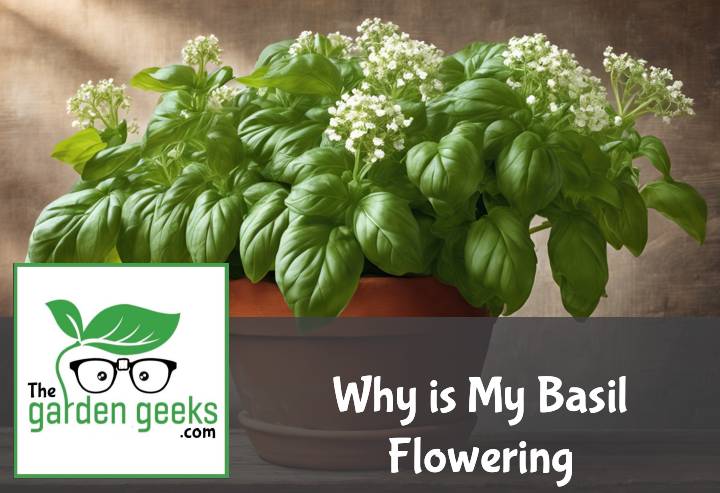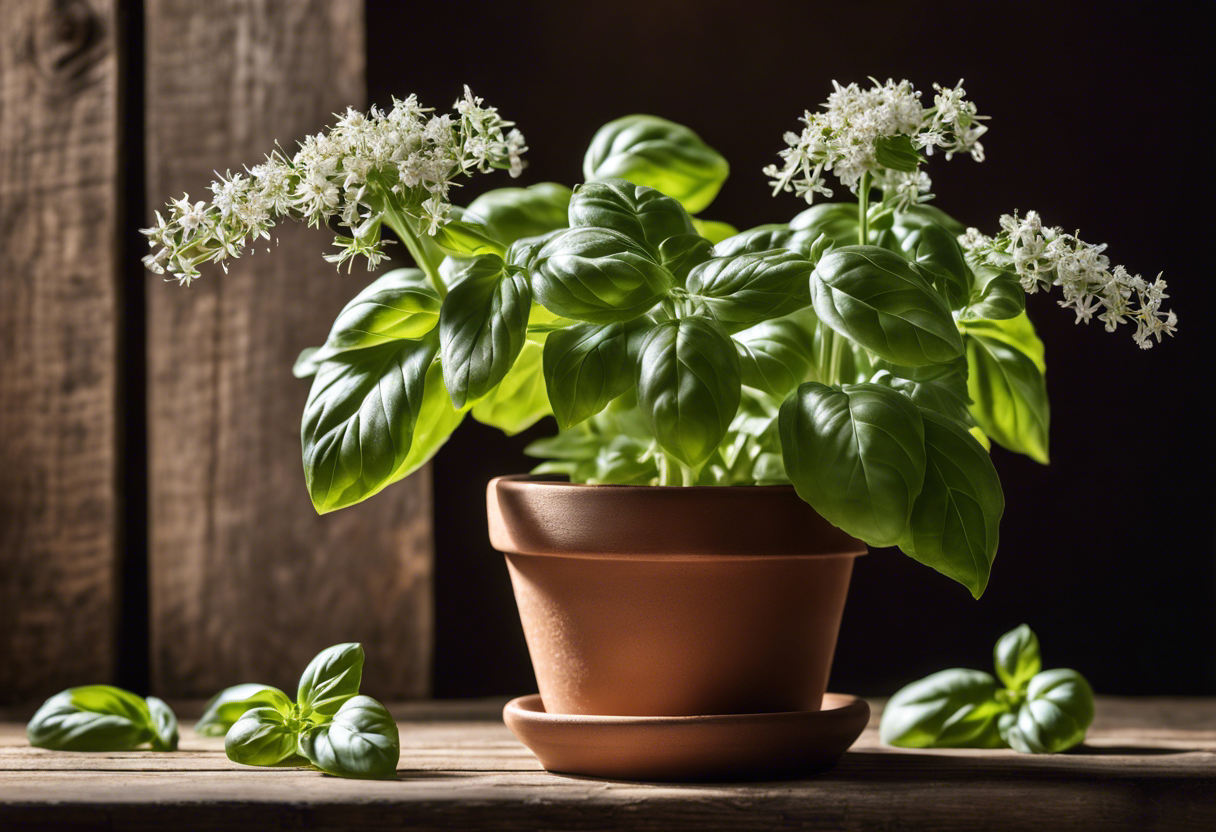Ever caught yourself staring at your basil plant, scratching your head and asking, Why is My Basil Flowering? Well, you’re not alone. I’ve been there too, sipping my morning coffee and wondering why my culinary companion decided to go all botanical on me.
But don’t sweat it! There’s no need for panic or a frantic Google search. It’s a natural process in the life of your basil plant. But more on that later. For now, keep reading about ‘Why is My Basil Flowering?’ You might just learn something new today!
Key Takeaways
- Basil plants flower when they reach maturity, usually in the heat of summer.
- Flowering can be a sign that the plant is under stress, possibly due to inadequate watering or nutrient deficiency.
- The taste of basil leaves changes after flowering, becoming less sweet and more bitter.
- To prevent flowering, regularly pinch off the tops of the plant and provide adequate water and nutrients.
- If your basil has already flowered, it’s not harmful; you can still use the leaves for cooking.
Understanding Basil Flowering
When you ask, “Why is my basil flowering?“, it’s because you’ve stumbled upon a natural part of the basil plant lifecycle. This phenomenon, often referred to as basil blooming, can have significant implications for the plant’s health and productivity. Let’s delve deeper into this fascinating process.
What is Basil Flowering?
Basil flowering, or bolting in basil, is when your herb starts sprouting flower spikes. It’s like puberty for plants – a sign that your basil has matured and is ready to reproduce. These flower spikes on herbs are quite a sight, with tiny white flowers adorning the greenery.
However, don’t be fooled by their beauty! When your basil blooms, it’s not necessarily good news for those of us who love its leaves in our pesto or margherita pizza. Once a basil plant flowers, it puts all its energy into reproduction rather than leaf growth. This can result in less flavorful leaves – a real bummer if you’re growing basil for culinary purposes!
The Life Cycle of Basil Plants
The life cycle of a basil plant begins with germination. From seed to sprout, this stage involves the development of roots and initial leaves. As the plant grows, it enters the vegetative stage where most leaf growth occurs.
Then comes the flowering or bolting stage – an important milestone in the lifecycle of aromatic plants like basil. This is when your herb starts producing flower spikes and seeds for future generations of tasty basil plants.
Flowering typically occurs when conditions are just right – usually during long summer days when temperatures are high. This phase signals that the plant has reached maturity and is ready to reproduce before completing its lifecycle.
Remember though, while flowering might be great from a botanical perspective, it might not be so great if you’re after those deliciously fragrant leaves. So, keep an eye on your basil and pinch off any flowers that start to form if you want to prolong its leaf-producing stage.
Causes of Basil Flowering
So, you’re asking yourself, “Why is my basil flowering?” Well, it’s not a mystery. There are several factors that can cause your basil to bloom. Let’s break it down.
Natural Progression and Age
First off, the natural progression to basil bloom is a part of the plant’s lifecycle. Just like us humans, basil plants go through an aging process. As they mature, flowering becomes a natural part of their growth cycle. It’s their way of saying “Hey, I’m all grown up now!”
The age-related basil flowering isn’t something to worry about. It’s just the plant doing its thing and moving along in its lifecycle. So next time you see those little flowers sprouting, remember it’s just your basil plant hitting puberty!
Environmental Factors Influencing Flowering
Now let’s talk about the environment. Yes, even plants are affected by their surroundings! Light exposure and temperature effects on basil bloom can be significant.
If your basil is getting too much sun or if the temperature is too high, it might start flowering earlier than expected. This is because these conditions stress out the plant and it goes into survival mode – producing seeds (aka flowers) for future generations.
On the flip side, if your basil isn’t getting enough light or if it’s too cold, this could also trigger flower growth as a last-ditch effort to reproduce before conditions get worse. So remember folks – keep an eye on that thermometer and make sure your plants are getting just enough sun!
Impact of Care and Maintenance on Flowering
Finally we come to care and maintenance – yes, how you look after your basil can affect whether or not it flowers! Overwatering or underwatering can lead to early blooming as the plant tries to survive under stressful conditions.
Proper care practices affecting basil bloom include regular watering, but not too much! Too much water can drown the roots and cause the plant to flower prematurely. On the other hand, if you’re not watering enough, your basil might start flowering as a cry for help.
So there you have it folks – the mystery of why is my basil flowering is solved! Remember to keep an eye on your plant’s age, its environment, and how you’re caring for it to ensure a healthy and happy basil plant.
Consequences of Basil Flowering
When your basil starts to bloom, it’s not just a pretty sight. The consequences of basil flowering can be quite significant, affecting everything from the plant’s taste and aroma to its overall health and longevity.
Effect on the Taste and Aroma of Basil
Ever wondered “Why is My Basil Flowering?” Well, one reason might be that Mother Nature is playing a little trick on you. You see, when basil flowers, it undergoes a bit of an identity crisis. The basil taste change can be quite noticeable. It becomes more bitter and less sweet – not exactly what you signed up for when you planted that little seedling.
But wait, there’s more! The aroma alteration in flowering basil is also something to note. That delightful scent that makes your kitchen smell like an Italian bistro? It changes too. The scent transformation in flowering basil can leave your nostrils feeling a tad confused.
Impact on Plant Health and Longevity
Now let’s talk about how this whole blooming business affects the plant itself. When basil flowers, it puts all its energy into producing those blooms. This could potentially impact the basil plant health post-flowering, as resources are diverted away from leaf growth.
On the flip side, there’s also an argument to be made about the potential benefits of flowering. Some gardeners believe that allowing the plant to flower can actually increase its lifespan – a sort of natural survival strategy if you will.
However, this theory has been met with some skepticism within gardening circles. Many argue that the longevity impact on flowering basil isn’t necessarily positive because once the plant has flowered, it often dies back or becomes less vigorous.
So there you have it folks – the ins and outs of what happens when your beloved basil decides to put on a floral show!
How to Prevent or Delay Basil from Flowering
Preventing your basil from flowering too early is a key part of basil care. It’s not just about keeping your herb garden looking pretty, but also about maintaining the flavor and aroma of your basil leaves. Let’s dive into some techniques that can help you prevent basil flowering or at least delay the basil bloom.
Pruning Techniques for Basil
Pruning is a gardener’s secret weapon against early blooming. By regularly snipping off the tops of your basil plants, you’re essentially telling them, “Hey, focus on growing leaves, not flowers!” This is one of the most effective basil pruning techniques to delay basil flowering.
But don’t go all Edward Scissorhands on your plants! Gentle and strategic cuts are what we’re aiming for here. The goal is to encourage bushier growth and keep those pesky flowers at bay. Remember, it’s all about maintaining your basil plants, not giving them a buzz cut!
Optimal Growing Conditions to Prevent Early Flowering
Now let’s talk about creating an environment that discourages early blooming. The right conditions can make a world of difference in preventing those flowers from popping up prematurely.
Firstly, light exposure plays a crucial role. Your basil loves sunbathing – so make sure it gets at least 6 hours of sunlight every day. This will keep it happy and focused on leaf production rather than rushing into flower mode.
Temperature-wise, remember that basil is a warm-weather plant. It thrives in temperatures between 70-90°F (21-32°C). Anything colder might stress out your plant and trigger early flowering.
Lastly, watering practices also play a part in this delicate balance. Overwatering can lead to weak growth and promote flowering. So water only when the soil feels dry to touch – think of it as the ‘Goldilocks’ approach to watering your basil plants.
So there you have it, folks! With these optimal basil growing conditions, you can help prevent early flowering and keep your basil leaves flavorful and aromatic for longer.
What to Do When Your Basil Starts to Flower
So, you’re asking yourself, “Why is My Basil Flowering?” Don’t fret! It’s a natural process and there are steps you can take to ensure your plant stays healthy. Let’s dive into some gardening tips for basil plant care during this flowering stage.
Harvesting Techniques Post-Flowering
When your basil starts flowering, it’s time to switch up your harvesting techniques. You’ll want to be gentle with the plant to maintain its health. Start by snipping off the flower heads. This encourages the plant to focus on leaf growth, which is what we want for a bountiful post-flowering basil harvest.
Next, prune your basil regularly. Regular pruning helps in maintaining basil plant health and also aids in maximizing basil yield. So don’t shy away from giving your basil a little trim now and then.
Using the Flowers: Culinary and Other Uses
Now that you’ve harvested those beautiful flowers, what do you do with them? Well, they’re not just pretty; they’re also quite versatile! For starters, try cooking with basil flowers. They add a subtle flavor twist to dishes like pasta or salad.
But wait, there’s more! These flowers aren’t just good in the kitchen; they have other uses too. Consider using them as garnish for cocktails or even as table decorations for that extra touch of elegance. That’s right – decorative uses of basil flowers are endless!
And let’s not forget about their potential medicinal benefits. Some folks swear by their calming effects when used in teas or infusions. So next time you’re feeling stressed out, why not brew up some soothing basil flower tea? Now that’s making the most out of your medicinal benefits of basil flowers!
To Wrap Up
So, you’ve been wondering Why is My Basil Flowering and we’ve dived into the garden of knowledge to find out. Just like a teenager rebelling against curfew, your basil plant is showing its maturity by flowering.
But now you know how to handle this botanical uprising! Nip those flowers in the bud, keep your basil on a strict watering and sunlight regime, and enjoy fresh, flavorful leaves all season long. It’s high thyme you took control of your herb garden!





